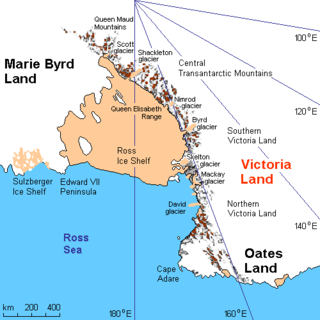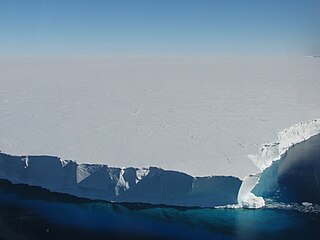 W
WBailey Ice Stream is an ice stream on the northern margin of the Theron Mountains, flowing west-southwest to the Filchner Ice Shelf. It was named by the UK Antarctic Place-Names Committee after Jeremy Thomas Bailey (1941–65), a British Antarctic Survey glaciologist, who with two companions died in a crevasse accident during a radio echo sounding traverse inland from Halley Station on 12 October 1965. On an earlier traverse in April 1965, Bailey sounded the upper portion of this feature.
 W
WThe Byrd Glacier is a major glacier in Antarctica, about 136 km (85 mi) long and 24 km (15 mi) wide, draining an extensive area of the polar plateau and flowing eastward between the Britannia Range and Churchill Mountains to discharge into the Ross Ice Shelf at Barne Inlet. Its valley below the glacier used to be recognised as one of the lowest point not to be covered by water on Earth, reaching 2,780 metres below sea level. It was named by the NZ-APC after Rear Admiral Byrd, US Navy Antarctic explorer.
 W
WDavid Glacier is the most imposing outlet glacier in Victoria Land, Antarctica. It is named after the geologist Edgeworth David and is fed by two main flows which drain an area larger than 200,000 square kilometres of the East Antarctic plateau, with an estimated ice discharge rate of 7.8 +/- 0.7 km³/year. The northern flow drains from Talos Dome to the Ross Sea, but the main branch of the stream is fed by a network of tributaries which drain a common area of the inner plateau around Dome C and converge in a spectacular icefall normally known as the David Cauldron. The north wall of David Glacier near its terminus is named D'Urville Wall after Admiral Jules Dumont d'Urville. As the David Glacier flows into the Ross Sea, it forms a floating mass known as the Drygalski Ice Tongue.
 W
WDenman Glacier is a glacier 7 to 10 nautical miles wide, descending north some 70 nautical miles, which debouches into the Shackleton Ice Shelf east of David Island, Queen Mary Land. It was discovered in November 1912 by the Western Base party of the Australasian Antarctic Expedition under Sir Douglas Mawson. Mawson named the glacier for Lord Denman, Governor-General of Australia in 1911, a patron of the expedition.
 W
WThe Echelmeyer Ice Stream, formerly known as Ice Stream F, is a glaciological feature of the West Antarctic Ice Sheet. It is an ice stream flowing west to the Shirase Coast to the north of the MacAyeal Ice Stream, and is one of several major ice streams draining from Marie Byrd Land into the Ross Ice Shelf. The ice streams were investigated and mapped by U.S. Antarctic Research Program personnel in a number of field seasons from 1983–84 and originally named Ice Stream A, B, C, etc., according to their position from south to north.
 W
WHorlick Ice Stream is a large ice stream on the featureless ice surface to the north of the main mass of the Horlick Mountains of Antarctica, draining west-southwestward, parallel to these mountains, to enter the lower portion of the Reedy Glacier. It was mapped by the U.S. Geological Survey from surveys and U.S. Navy air photos, 1960–64, and was named by the Advisory Committee on Antarctic Names in association with the Horlick Mountains.
 W
WLambert Glacier is a major glacier in East Antarctica. At about 50 miles (85 km) wide, over 250 miles (400 km) long, and about 2,500 m deep, it holds the Guinness world record for the world's largest glacier. It drains 8% of the Antarctic ice sheet to the east and south of the Prince Charles Mountains and flows northward to the Amery Ice Shelf. It flows in part of Lambert Graben and exits the continent at Prydz Bay.
 W
WMertz Glacier is a heavily crevassed glacier in George V Coast of East Antarctica. It is the source of a glacial prominence that historically has extended northward into the Southern Ocean, the Mertz Glacial Tongue. It is named in honor of the Swiss explorer Xavier Mertz.
 W
WPhilippi Glacier is coastal glacier about 15 mi long, flowing N to the E end of the West Ice Shelf, 15 mi W of Gaussberg. Delineated from aerial photographs taken by U.S. Navy (USN) OpHjp, 1946–47. Named by the ANCA for Emil Philippi, geologist with the German Antarctic Expedition (GerAE) under Erich von Drygalski, 1901–03, who made scientific observations in the vicinity of Gaussberg.
 W
WPine Island Glacier (PIG) is a large ice stream, and the fastest melting glacier in Antarctica, responsible for about 25% of Antarctica's ice loss. The glacier ice streams flow west-northwest along the south side of the Hudson Mountains into Pine Island Bay, Amundsen Sea, Antarctica. It was mapped by the United States Geological Survey (USGS) from surveys and United States Navy (USN) air photos, 1960–66, and named by the Advisory Committee on Antarctic Names (US-ACAN) in association with Pine Island Bay.
 W
WThe Recovery Glacier is a glacier flowing west along the southern side of the Shackleton Range in Antarctica. First seen from the air and examined from the ground by the Commonwealth Trans-Antarctic Expedition in 1957, it was so named because of the recovery of the expedition's vehicles which repeatedly broke into bridged crevasses on this glacier during the early stages of the crossing of Antarctica. It is at least 100 km (60 mi) long and 64 km (40 mi) wide at its mouth.
 W
WThe Scott Glacier is a major glacier, 120 miles (190 km) long, that drains the East Antarctic Ice Sheet through the Queen Maud Mountains to the Ross Ice Shelf. The Scott Glacier is one of a series of major glaciers flowing across the Transantarctic Mountains, with the Amundsen Glacier to the west and the Leverett and Reedy glaciers to the east.
 W
WShirase Glacier is a large glacier entering Havsbotn, the bay that forms the head of Lutzow-Holm Bay in Antarctica. The area occupied by this feature was first mapped as a bay and named Instefjorden by the Lars Christensen Expedition (LCE) of 1936–37. Surveys by Japanese Antarctic Research Expedition (JARE) of 1957–62, revealed the large glacier in this position which they named after Lt. Nobu Shirase, leader of the Japanese Antarctic Expedition of 1911–12.
 W
WThe Stancomb-Wills Glacier is a large glacier that debouches into the eastern Weddell Sea southward of Lyddan Island. The glacier was discovered in the course of the U.S. Navy LC-130 plane flight over the coast on November 5, 1967, and was plotted by the United States Geological Survey (USGS) from photographs obtained at that time. The name was applied by the Advisory Committee on Antarctic Names (US-ACAN) in 1969.
 W
WThwaites Glacier, sometimes referred to as the Doomsday Glacier, is an unusually broad and vast Antarctic glacier flowing into the Pine Island Bay, part of the Amundsen Sea, east of Mount Murphy, on the Walgreen Coast of Marie Byrd Land. Its surface speeds exceed 2 kilometres per year near its grounding line. Its fastest flowing grounded ice is centred between 50 and 100 kilometres east of Mount Murphy. It was named by the Advisory Committee on Antarctic Names in 1967 after Fredrik T. Thwaites (1883–1961), a glacial geologist, geomorphologist and professor emeritus at the University of Wisconsin–Madison. The historian Reuben Gold Thwaites was his father.
 W
WTotten Glacier is a large glacier draining a major portion of the East Antarctic Ice Sheet, through the Budd Coast of Wilkes Land in the Australian Antarctic Territory. The catchment drained by the glacier is estimated at 538,000 km2 (208,000 sq mi), extending approximately 1,100 km (680 mi) into the interior and holds the potential to raise sea level by at least 3.5 m (11 ft). Totten drains northeastward from the continental ice but turns northwestward at the coast where it terminates in a prominent tongue close east of Cape Waldron. It was first delineated from aerial photographs taken by USN Operation Highjump (1946–47), and named by Advisory Committee on Antarctic Names (US-ACAN) for George M. Totten, midshipman on USS Vincennes of the United States Exploring Expedition (1838–42), who assisted Lieutenant Charles Wilkes with correction of the survey data obtained by the expedition.